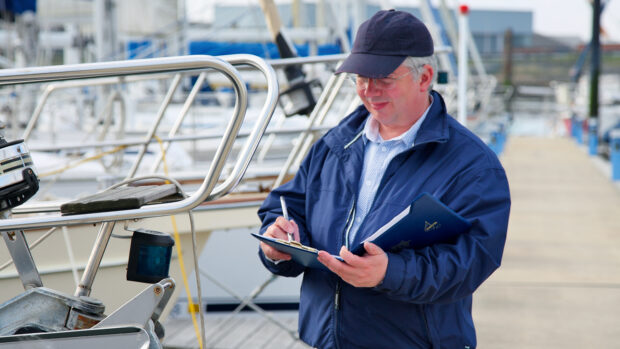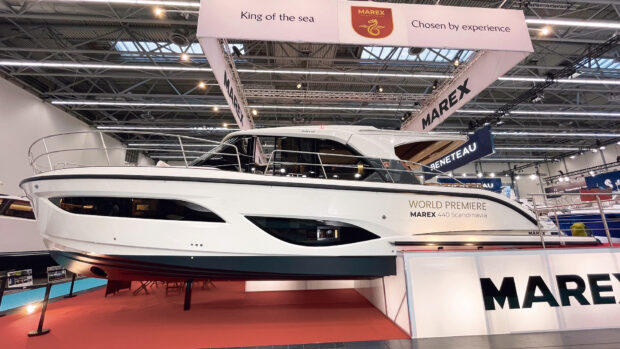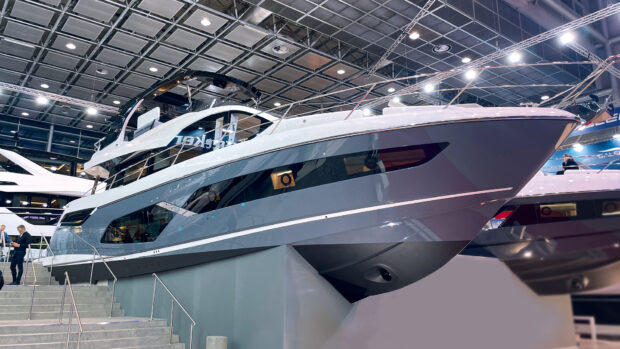As the name suggests a bow thruster or stern thruster is a means of propelling a boat sideways, usually to help with manoeuvring into a berth
Bow thrusters or stern thrusters are mostly fitted at the bow and/or stern of a yacht, so the skipper can push one or both ends towards or away from the dock.
They are particularly useful when trying to counter a strong side wind or current that is making it hard to control the boat. They can also help you slot into a short berth or when your close-quarters control is compromised by steering or engine failure.
Bow or stern thruster?
Bow thrusters are more common than stern thrusters as the bow is more prone to being blown off course. This is because the stern is heavier and more deeply immersed due to the shape of the hull and location of the engines. You also have better control over the stern from the main engines and steering due to the location of the drives and/or rudders.
That said, stern thrusters are an increasingly common sight on displacement craft over 40ft, planing boats over 60ft and single-engined shaft drive craft of all sizes, which are notoriously hard to steer in astern due to the prop walk effect of a single large propeller. They are often fitted in addition to a bow thruster, as it allows you to manoeuvre both ends of the boat independently or together.

Most bow thrusters are installed in a tunnel through the hull just below the waterline
How do they work?
The vast majority of them use one or two propellers set inside a tube, which are powered by either an electric or hydraulic motor. Most bow thruster tubes are mounted through the hull just underneath the waterline. Most stern thrusters, on the other hand, are mounted outside the hull on the transom as close to the centreline as possible. There are a few exceptions, such as water jet thrusters, which use high-pressure jets instead of propellers, externally mounted ‘torpedo’ thrusters and retractable thrusters which retract inside the hull when not in use.
What type do I need?
That depends on the size and drivetrain of your boat. For craft up to 40ft, an electric tube bow thruster is likely to be the most affordable option and good enough for the task in hand, provided you only use it in relatively short bursts.
Electric bow thrusters come in a variety of sizes, power ratings and voltages (12V and 24V DC and 250V AC). Speak to your local installer and study the manufacturers’ specs to see what’s right for your boat, but if in doubt, go for a size larger than specified. Too much power is easy to deal with. Not enough power is a waste of money.

Here, a bow thruster is being used to push the bow of the boat away from the pontoon
The disadvantage of a basic electric thruster is that they are prone to overheating and cutting out when used continuously for more than a few seconds. They are also either on or off – you can’t vary the amount of power.
For smaller displacement craft, such as river launches and sailing boats, an externally mounted thruster can also be an effective low-cost solution. In this instance the motor and propeller are fitted inside a single waterproof hydrodynamically shaped pod that is mounted underneath the hull so all you have to do is fix it to the hull and drill a small hole for the wiring.
Above 40ft it’s worth considering something more powerful with superior control, such as a proportional or hydraulic thruster.

Stern thrusters tend to be mounted outside the hull on the transom
What’s a proportional thruster?
Essentially, it’s a thruster with an electronic throttle that allows you to vary the amount of power it produces. The further you push the lever over to one side the more speed/thrust it delivers. Not only does this give you finer control over the boat, minimising unwanted noise and disturbance, but it means you can run the thruster for longer at reduced power without it cutting out.
This can be particularly useful when pinning a boat against a dock while you attach the lines – some proportional thrusters have a hold button specifically for this purpose.
What about hydraulic bow thruster or stern thrusters?
Hydraulic thrusters are driven by very high-pressure oil fed from a pump on the main engines or generator to a small hydraulic motor on the thruster. These are considered the gold standard of thrusters as they are usually more powerful and can run continuously at full power without overheating.

Torpedo-style thrusters are a cost effective solution for slow moving displacement craft
However, they require more space (for the oil tank and cooling) and are costlier to install because of the extra hardware and associated plumbing of high-pressure lines from the engineroom to the thruster(s). As a result they tend to be used on boats of 65ft-plus or those already fitted with other hydraulic items such as stabilisers, winches and cranes. If connected to the generator power take off, they also need an auto shut off for the generator’s electric output so the sudden load from a hydraulic pump doesn’t overload or stall the unit.
And water jet thrusters?
These have a powerful central water pump fitted inboard linked to four outlet nozzles located at each corner of the hull. This gives good control of both ends of the boat and is much quieter than a propeller system but is only really suitable for boats up to 30ft due to the limited power output.
Article continues below…

Everything you need to know about Watermakers

Everything you need to know about boat decking
Why are propeller bow thruster or stern thruster so noisy?
Given that both electric and hydraulic motors are typically quiet in operation, it’s surprising how much noise most thrusters make. This is largely due to cavitation from the propeller tips. The small diameter and high speed of the propellers needed to push a heavy boat around creates low pressure spots on the tips that momentarily cause the water to vaporise into bubbles which then collapse, generating shock waves that resonate through the boat. The result is a rattling noise that sounds far worse than it is.

Most thrusters tend to be professionally installed such as this tidy-looking Sidepower stern thruster fitted by Sleipner dealer Osmotech UK
Can you make them quieter?
Up to a point. If you haven’t yet fitted one, go for the largest diameter tube possible, make the area around it as stiff as possible (to reduce structural-borne vibration) and try to encourage a smooth flow of water into the tube rather than sharp edges that increase the likelihood of cavitation. A proportional thruster can also reduce noise by giving you the option to run it slower for longer.
If you already have a bow thruster fitted, you may be able to swap the propeller for a modern composite low-noise, skew-tip design.
Are retractable thrusters a good idea?
Originally this was a big ship idea that has now moved down to the pleasure boat market. The idea is to reduce drag by bringing the unit up inside the hull when not in use to leave a flush surface. They are a little more complex to install because it involves cutting a hole in the centre of the hull, which is then likely to need additional reinforcement.
While this should reduce the amount of marine growth on the actual propellers, the retractable mechanism itself is prone to debris or marine growth. Having a retractable thruster jammed half open makes boat handling even more difficult.

A Vetus Pro thruster without the usual accompanying tunnel
Can you install a bow thruster or stern thruster yourself?
It’s possible but we wouldn’t advise it unless you really know what you’re doing. Most bow thrusters require you to drill a substantial horizontal hole through the bow below the waterline into which the thruster tube is inserted and bonded into place. This needs to be low enough to prevent the thruster from sucking in surface air when manoeuvering around a marina, but high enough for it to lift clear of the water when planing to minimise drag through the water.
Obviously this needs to be watertight and may require additional reinforcement due to weakening of the surrounding structure. Most boatbuilders now offer bow and/or stern thrusters as an optional factory fit extra on craft over 25ft long. This is such a popular option that some builders automatically fit a bow tube to every boat as standard but only cut the ends open and fit a thruster when the customer orders one.
What about electrical connections?
Electric DC thrusters need a very high instant current. For example, the smallest unit from Vetus needs 100A when operating, while a larger 8hp unit needs over 600A. The supply cables must be big enough to cope with the load while the distance from the battery to the motor should be kept as short as possible to minimise voltage drop. This often involves fitting separate thruster batteries close to the unit, which may affect your boat’s for and aft trim, not to mention a dedicated charger.

A Sleipner retractable thruster
Are there any other problems I should be aware of?
Most modern marine engines are computer-controlled with a “black brain box” controlling everything. Sudden voltage drops when an electric bow thruster is used can momentarily starve the power from the engine’s control system and cause it to stall. Precisely what you don’t need when berthing your boat!
The more advanced units have built-in inverters, which soften the electric surge by applying a proportional voltage for a few seconds. This may cause a minor delay between pushing the button and full thrust being delivered.
Thrusters are vulnerable to fouling growth and galvanic corrosion. Composite propellers and tubes can be coated with conventional copper-based antifouling paint but metal ones will require special propeller antifouling. Most thrusters have sacrificial anodes to prevent galvanic corrosion. This will need replacing at regular intervals depending on your area’s wear rate.

The exterior also needs filling and fairing so water can flow easily past the entry lip
What about hydraulic bow thruster or stern thruster installations?
A hydraulic thruster needs three high-pressure pipes connecting the oil pump on the main engines to the motor. I strongly advise fitting a hydraulic oil pump to each engine, connected with a splitter unit on the control valve chest. I have seen pumps fitted to just one engine, but invariably, if one engine fails or you get a rope around the propeller, it will be the engine with the pump. With a splitter unit fitted your thrusters will work using one engine only, just a little slower.

Remote handsets are particularly handy on larger boats where you may need to move away from the helm when coming alongside
How do you control them?
Most thruster controls are very simple. They normally have an on/off switch to power them up in readiness for docking and a port/starboard lever or pair of buttons to run them in the required direction. Proportional thrusters have a lever so that the further you push it the more power you get. Some units also have the option of a remote control enabling you to move around the boat when docking.

Joysticks can now be used to combine thrusters and engines for simple one-touch berthing control
How do joystick systems work?
Some bow and stern thrusters can now be linked to the steering and main engines using sophisticated software and a simple joystick control. All you have to do is push or twist the joystick in the direction you want to go and the computer will then decide what combination of thrusters, rudder position and engine drive is needed to move the boat in that direction. While not quite as effective as steerable pods, this does make a shaftdrive boat almost as easy to park as an IPS one.

Thrusters take the stress out of manoeuvring in tight spaces
What future developments should I be aware of?
Many joystick systems now have a skyhook or station hold button that keeps the boat locked in position using GPS location and the boats’ engines and thrusters to prevent it drifting. A number of electronics manufacturers also offer varying degrees of berthing assistance using cameras and proximity sensors in conjunction with joystick control. At some point, full automated berthing is also likely to happen. In all cases thrusters will play a key role in making this possible.
Which make of bow thruster or stern thruster should I opt for?
As always, that comes down to price, your boat’s requirements, local availability and personal preference. Sleipner (Sidepower), Vetus, Quick and Lewmar are the main players in Europe.
Based on the boats we test, we’d say Sleipner thrusters are the most popular factory-fitted option.
 If you enjoyed this….
If you enjoyed this….
Motor Boat & Yachting is the world’s leading magazine for Motoryacht enthusiasts. Every month we have inspirational adventures and practical features to help you realise your sailing dreams, as well as tests and news of all the latest motorboats.
Plus you’ll get our quarterly Custom Yachting supplement where we share the last on offer in the superyacht world and at the luxury end of the market.
Build your knowledge with a subscription delivered to your door. See our latest offers and save at least 30% off the cover price.


 If you enjoyed this….
If you enjoyed this….





